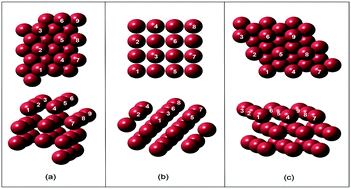Steam methane reforming on a Ni-based bimetallic catalyst: density functional theory and experimental studies of the catalytic consequence of surface alloying of Ni with Ag
Abstract
A comprehensive understanding of the role of bimetallic alloys in surface steam reforming (SMR) reactions and carbon formation on real catalysts at an atomic level remains a challenge due to their different material properties and pressures. We report here a density functional theory (DFT) study and an experimental study of the effects of the surface composition of a Ni/Ag alloy on methane activation and steam methane reforming compared to those of a pure Ni catalyst. The Ni/Ag bimetallic catalyst demonstrates better surface alloying compared to other bimetallic catalysts, which is confirmed by X-ray photoelectron spectroscopy (XPS) and hydrogen chemisorption. The DFT calculation shows that Ag selectively substitutes for the more active Ni sites in the order Ni(211) > Ni(100) > Ni(111), so that the substitution of Ag on the Ni surface has a profound influence on the activities of the sites near Ag. These sites surrounding the Ag atom are inactive to C–H activation in the methane molecules, and Ag serves as a blocking agent to block the more active sites on the Ni nanoparticles, as suggested by both the kinetic and DFT studies. Furthermore, the study shows that the apparent activation energy increases with increasing fraction of Ag on the catalyst surface. A better understanding of the chemistry and catalytic consequence of surface alloying in SMR reactions is achieved by combining well-controlled surface alloying, detailed kinetic assessment and the DFT study. Thus, this approach provides the key to understanding the mechanism for suppressing carbon formation and is expected to have a significant implication on the general methods of SMR bimetallic catalyst design in order to have better activity and stability.



 Please wait while we load your content...
Please wait while we load your content...